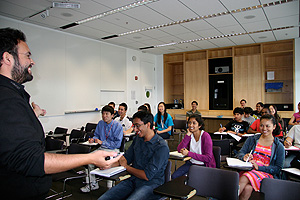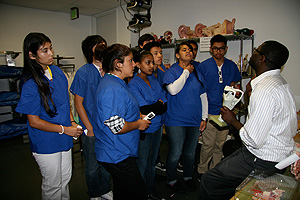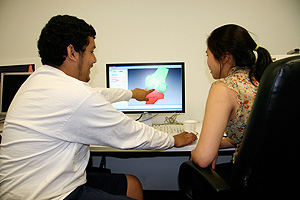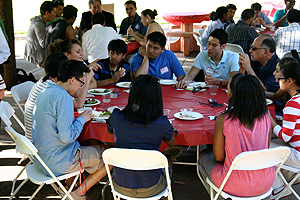July 11, 2011 - By Susan Young
For many high school and college students, July is a time for swimsuits and summer jobs, but for others, it’s the season to hang out in labs with human cadavers, in hospitals following physicians as they work, and in classrooms learning about immune cells. It’s time for summer educational programs.
The School of Medicine has a long commitment of providing summer educational opportunities to young people, and this year is no exception, though funding these programs involves new and difficult challenges.
These experiences, however, are seen as vital to producing future generations of scientists. In these programs, the medical school opens its doors to highly motivated students interested in the biomedical sciences and lets them explore health and science careers with first-hand experience. Many of these students come from under-resourced schools or low-income families; a few weeks on campus can be an important step toward achieving a dream career as a clinician or scientist.
By trading their shorts for scrubs, these students can take advantage of Stanford’s advanced facilities and make connections that will serve them in their educational and professional futures, many of which will be in the biomedical field. Here’s a sampling of what the School of Medicine can offer budding health professionals:
Every year a select group of high school students forego the lazy days of summer to pursue cutting-edge research through one of the medical school's internship programs. This video follows one high school senior as she pursues her interests in digital anatomy and stem cell research. Length: 3 min 52 sec

Graduate student Jordan Price teaches a group of students in the Stanford Institutes of Medicine Summer Research Program about immune cells.
SIMR: Stanford Institutes of Medicine Summer Research Program
Admits: 50-60 U.S. high-school students
Goal of 30-50 percent under-represented minority or low-income students
21 attendees have been semi-finalists or finalists in the national Intel or Siemens competitions
Mark Nishimura, 17, of Palo Alto High School, sits at a computer and, with a few strokes of the keys, tinkers with the behavior of genes. The computer chugs through a huge collection of data on the amounts of different genes produced in disease states, and Nishimura looks at how adding new factors affects the web of gene interaction. His project, part of his internship with the Stanford Institutes of Medicine Summer Research Program, could find the molecular basis of illness for some patients. “The work is about doing something meaningful, which is something I never really got in high school,” said Nishimura, who is working in the lab of Atul Butte, MD, PhD, associate professor of systems medicine in pediatrics.
Butte is one of nearly 60 faculty members who provide research opportunities through SIMR. “This program would not work if the scientists weren’t willing to take the students into the labs,” said P.J. Utz, MD, associate professor of medicine and a founder of the program.
SIMR students take on independent research projects under the guidance of professors, postdocs and graduate students. At the end of eight weeks, the students will present their work in a poster session where they can show off all they’ve learned from their research experience as well as the lectures and workshops they attend as part of the program.
SIMR evolved from a summer program in immunology started by Utz in 2000. Utz looks back at his own experience in a summer biomedical internship as key to his career choice. “I was in a program like SIMR and, by the end of my summer, I knew I wanted to be a biomedical researcher, combining research with patient care,” said Utz. “And that’s what I do today.”
Most of SIMR’s students come from the Bay Area and all receive a $1,500 stipend for the summer. “Some students who come here may be a breadwinner for their family, so we need to pay those students,” said Utz.
SIMR boasts a strong record in national science competitions. Four students from Butte’s lab alone have made it to national competitions.
Butte has hosted summer interns for the last five years in his computational biology lab, many of them through SIMR. “Nothing gets them going more than the fact that they own their project, and the fact that whether it succeeds or fails is up to them,” he said.
Butte encourages all his colleagues to accept summer students. “These students aren’t a distraction,” he said. “Put them on a project, they’ll feel like they own it and they can get all the way to publication and they could be semifinalists in national competitions. And that makes your lab shine.”

MD/PhD student AbdulRasheed Alabi (right) demonstrates the anatomy of the throat to a group of students in the Stanford Medical Youth Science Program.
SMYSP: Stanford Medical Youth Science Program
Admits: 24 low-income and under-represented minority students from Northern and Central California high schools
Students live on campus for five weeks, living expenses and tuition paid
84 percent of alumni are college graduates, compared to 10-15 percent of same age group and ethnic distribution
The Stanford Medical Youth Science Program, which focuses on low-income and under-represented minority high school students from Northern and Central California, has been drawing students into the biomedical sciences for over 25 years. During their five weeks living on campus, SMYSP students shadow doctors and other health professionals, attend workshops on community health and even practice for the SATs. The program covers a broad swath of skills and knowledge that these teenagers will need on their path to a biomedical profession, including admission to college and medical or graduate school.
Marilyn Winkleby, PhD, professor of medicine, founded the program in 1988. Her early experiences as a scientist from a disadvantaged background inspired her to help create a program that would diversify the scientific and medical workforces. “When I first came here, it was obvious to me that here were very few people from low-income backgrounds and under-represented minorities who were involved in science careers,” said Winkleby. “We are trying to find students who have faced a lot of adversity in their lives, but are resilient, and who love and are motivated by science and health.”
The organizers of SMYSP also hope to reduce health disparities in communities that are not well-represented in the medical field. For example, although one-third of Californians are Latino, only 5 percent of the state’s physicians belong to that ethnicity, according to a 2008 report from the Center for the Health Professions at UC-San Francisco.
“These types of programs allow us to reach out to students who don’t feel they are competitive enough or academically talented enough to pursue an undergraduate degree in a science, technology or mathematics field,” said executive director Judith Ned, EdD. The paths of SMYSP’s alumni suggest that the program works: More than 80 percent of its 550 alumni have graduated from college, many of them the first in their family to do so. Almost half of SMYSP’s alumni become health professionals.
“These programs are of tremendous value for Stanford as far as the perception of Stanford in low-income communities and students,” said Winkleby. “Students from under-resourced schools may think they don’t belong on a campus like Stanford. Spending time in Stanford’s labs, hospitals and lecture halls and being mentored by its students and faculty can change that.”

J.C. Jaco shows fellow Digital Anatomy intern Beverley Chiang his 3D model of a knee.
Digital Anatomy lab
Admits: approximately 10 students, with a preference for those from local schools
Students combine work on computational models with projects in other labs
Students create 3D interactive anatomy models to be used by educators
In a quiet basement room on the medical center campus, J.C. Jaco, 17, of Eastside College Preparatory in East Palo Alto, examines a 3D model of the human knee on his computer screen. He highlights the ligaments, bones and blood vessels with bright colors and rotates the model to examine how the pieces all work together.
As an intern in the Digital Anatomy summer program, Jaco combines his computer work with another project in a different department; in his case, the Athletic Department. “I am researching ACL tears,” said Jaco. “We can simulate knee movements through these computer programs and then show athletes ways to prevent injuries.”
Another Digital Anatomy student, Leslie Vera, 17, of KIPP San Jose Collegiate School is complementing her digital examination of a two-headed calf’s skull with her work on bone regeneration in the lab of Jill Helms, PhD, DDS, associate professor of surgery.
The Digital Anatomy lab has run an informal internship program for the last 10 years. The lab uses 3D modeling tools and advanced computer imaging to teach students, from high schoolers to collegians, about the human body. The Bassett Collection, a stereo-projected set of thousands of images of the human body, and a unique virtual dissection table give students an inside look at human construction. That education is fleshed out in sessions with real cadavers.
“The students can actually hold a heart or a brain in their hands,” said Paul Brown, DDS, consulting associate professor of anatomy and director of the Digital Anatomy summer internship program. “It’s very memorable for them.” The cutting-edge teaching tools of the Digital Anatomy lab are also used by the SMYSP and SIMR programs.
While learning how to analyze and label computerized models of the body, the students create 3D projections that will later be used as teaching tools. The models they create will become part of a curriculum for a high school anatomy teacher who is also spending her summer in the Digital Anatomy lab. “The kids are really capable,” said Brown. “When the students finish one thing, they ask what they can do next.”

Students in the Health Careers Opportunity Program enjoy a Friday evening BBQ along with director Ron Garcia (third from right).
HCOP: Health Careers Opportunity Program
Admits: 25 college sophomores and juniors; targets Bay Area students
Students live on campus for six weeks, living expenses and tuition paid
Equips students for futures in medicine, from clinical shadowing to MCAT prep
It’s not just high school students who can take advantage of special opportunities in the School of Medicine in the summer. Students enrolled in Bay Area colleges can participate in the Health Careers Opportunity Program, which aims to bolster college sophomores and juniors who seek a career in medicine but may face some educational or academic barriers. This summer, HCOP returned from a two-year funding-related hiatus.
“I’ve never had as much hands-on experience,” said Sarah Marks, 25, who attends San Jose State University and San Jose City College, of the program. Over their six weeks on campus, Stanford’s HCOP students attend cell biology lectures and anatomy labs, review medical literature, and shadow physicians in Stanford’s hospitals and clinics. They also work with mentors to figure out the best strategies for getting into medical school and even practice for the MCAT.
This year, the students will also meet with public health officials from San Mateo County to discuss current issues for the region. Like SMYSP, the curriculum of HCOP emphasizes civic engagement. Ronald Garcia, PhD, director of HCOP, views the program as an “investment in the quality of care that is available to our citizens. Almost all participants speak another language in addition to English. Given the growing diversity of our region, we can benefit from students who come from this diverse background and just need some help along the way,” he said.
“This experience gives us the chance to push ourselves and show what we, as individuals, can do at a great institution,” said Marks, who hopes to one day improve health care in all neighborhoods of San Francisco, even her under-served childhood neighborhood, Hunters Point.
Susan L. Young is a science-writing intern in the Office of Communication & Public Affairs.
About Stanford Medicine
Stanford Medicine is an integrated academic health system comprising the Stanford School of Medicine and adult and pediatric health care delivery systems. Together, they harness the full potential of biomedicine through collaborative research, education and clinical care for patients. For more information, please visit med.stanford.edu.